ISSN ONLINE(2278-8875) PRINT (2320-3765)
ISSN ONLINE(2278-8875) PRINT (2320-3765)
S. N. Patil1, B. P. Ladgaonkar2
|
| Related article at Pubmed, Scholar Google |
Visit for more related articles at International Journal of Advanced Research in Electrical, Electronics and Instrumentation Engineering
Along with magnetic properties, the spinel ferrites exhibit promising electrical properties, deployment of which results into evolution of new area of applications as the electronic sensor materials. The electrical properties significantly depend upon the environmental compositions, for which it has been exposed. The electrical resistance of these sensor materials varies not only with gas concentration but also with change in water vapour concentration. With the view to develop an embedded technology based smart sensor module for humidity measurement a sensor material NixZn1-xFe2O4 are synthesized by chemical method and characterized by XRD and IR tools. The x-ray powder diffraction reveals the formation of single phase spinel ferrite, which is also supported by the IR absorption bands attributed to tetrahedral (A) site and octahedral (B) sites. Employing embedded philosophy, the sensor module is designed about AVR ATmega8L microcontroller for humidity measurement. The thick film of materials under investigation, prepared by screen painting technique, is used to sense the concentration of water molecules. Analog part of the system is wired about highly precise instrumentation amplifier AD620. Deployment of on-chip ADC of 10-bit resolution causes to increase in the preciseness of the results. The system is calibrated to the humidity in RH%. The data shown by the system under investigation reveals close match with the standard data.
Keywords |
| Polycrystalline ferrites, Humidity sensor, Electrical resistance, Protonic conduction, Embedded system. |
INTRODUCTION |
| Electrical properties of the ferrites, wherein interesting conduction mechanism is exhibited are found important. The properties such as DC resistivity, thermoelectric power, dielectric constant, dielectric loss etc [1] show significant dependence on temperature and frequency of applied ac field. It is also sensitive to the microstructure, grain boundary, grain size and porosity. The dc conductivity results show the influence of magnetic ordering and exhibit negative temperature coefficient of resistance, whose value suddenly changes at Curie point [2]. The electrical resistance of ferrite compositions, significantly vary with the change in environmental gas concentration [3]-[6]. Moreover, it is also sensitive to the humidity, the water vapour, dissolved in the air [7]-[10].The transport phenomenon results into thermoelectric power and Seebeck coefficient, which gives information regarding type of charge carriers [10]. The dispersion of dielectric constant and dielectric loss with frequency of applied ac field attributes polarization of in the ferrite materials. Therefore, it can be said that the polycrystalline soft ferrites show very interesting electrical properties [11]-[12]. |
| It is found that the, Zinc substituted in NiFe2O4, has stable valency (+2) and hence, it does not contribute to the conduction mechanism, which results into ferrites of high resistivity. Moreover, Zinc ion in spinel ferrites occupies tetrahedral (A) site [13]. Hence, it cannot contribute to the electrical conductivity. The Nickel, on substitution, partially occupies both tetrahedral and octahedral sites and hence, it contributes in the conduction process [14]. Therefore, the effect humidity on electrical resistivity of zinc substituted Ni ferrites is studied and the results regarding this investigation are interpreted. Now days, field of embedded system design for dedicated application is becoming more pervasive [15]. It finds wide application potential in diverse sectors. Measurement and control of environmental parameters of localized area is the need of hours for agriculture, industrial, medical, storage plants etc. sectors. Design of an embedded system for such sophisticated instrumentation is the suitable solution. Therefore, deploying polycrystalline ferrites materials a smart sensor module is designed to measure humidity and presented in this paper. |
II. EXPERIMENTAL |
| Synthesis of sensor materials: The compositions of NixZn1-xFe2O4 (x=0.2, 0.4, 0.6 and 0.8) ferrites were prepared by co-precipitation method and characterized by using X-ray powder diffraction. The computerized X-ray powder diffractometer, with CuKïÃÂá radiations, (ïÃÂì1 = 1.540Ao and ïÃÂì2 = 1.544Ao) have been employed with nickel as filter. Therefore, it filtrates the KïÃÂâ lines of the copper target. |
| The DC electrical resistivity measurements for the composition of NixZn1-xFe2O4 (x= 0.20, 0.40, 0.60 & 0.80) ferrites were carried in the temperature range from the room temperature to 500 0C by using two-probe method. Automatically temperature controlling electric furnace is used for application of temperature. The silver paste is used to achieve Ohmic contacts between the electrodes to measure the resistance. The temperature dependant resistance is measured by using highly precise LCR meter model Aplab 4290. Moreover, the resistance of the thick film, prepared by screen printing method, is measured with variable humidity from 30 RH % to 95RH% by exposing the compositions to the humid environment by using highly calibrated and fully controlled Humidity Chamber. The precision LCR meter model Aplab 4290 is used for resistance measurement. |
| B. Design of smart humidity sensor module: Deploying polycrystalline NixZn1-xFe2O4 (x=0.2, 0.4, 0.6 and 0.8) ferrite materials, smart humidity sensor module is designed, wherein the on chip resources of AVR ATmega8L are availed. It ensures the design of both hardware and software. The schematic of hardware of an embedded system designed for present sensor module is depicted in fig 1. |
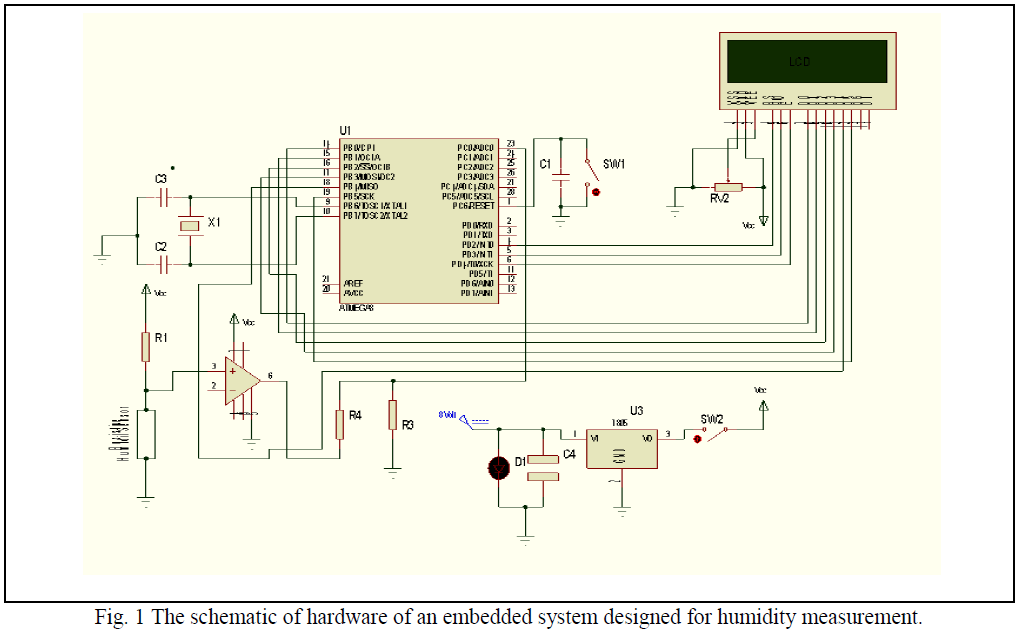 |
| i)Hardware: The system comprises the hardware, wherein the analog part is wired about AD620 as a instrumentation amplifier. The humidity dependent emf is read and strengthened by employing signal conditioner stage and then subjected to microcontroller for further processing. The sensor, fabricated by screen printing technique, as described earlier, is availed for present system [Fig 1]. The sensor is powered with +5 Volt supply and resultant emf is read into the system through instrumentation amplifier AD620. The signal is digitized by employing on chip 10-bit ADC of AVR ATmega8L microcontroller [16]. Analog to digital converter is accessed through firmware designed for this dedicated application. On configuration of ADC to 10-bit resolution, the preciseness in the data is significantly increased. A smart LCD form Hitachi is wired in time delay mode to ensure digital read out. |
| ii)Software: The firmware is developed in embedded C using Codevision AVR, the integrated development Environment (IDE) and programmed into target device memory by using Ponyprog. The empirical relation obtained from process of data analysis is employed in the software for data processing and conversion of same into humidity (RH %) scale. Thus employing the thick film of NiZnFe2O4 sensor materials a smart sensor module is designed and implemented. |
III. RESULTS AND DISCUSSION |
| X-ray diffractogram of polycrystalline powdered compositions of NixZn1-xFe2O4 (x = 0.2, 0.4, 0.6, 0.8) ferrites were obtained from powder diffractometer. A diffractogram, of typical composition (x = 0.6) is shown in the fig 2. The diffractogram have well defined reflections without any ambiguity, with (311) as a prominent reflection, which is a prime characteristic of the structure [17]. This suggests the formation of cubic spinel structure for all compositions [18]. The well defined absorption bands observed in the IR spectrograph, at 400 cm-1 and600 cm-1 supports the formation of single phase cubic spinel ferrites shown in fig 3. This confirms the formation of spinel ferrites |
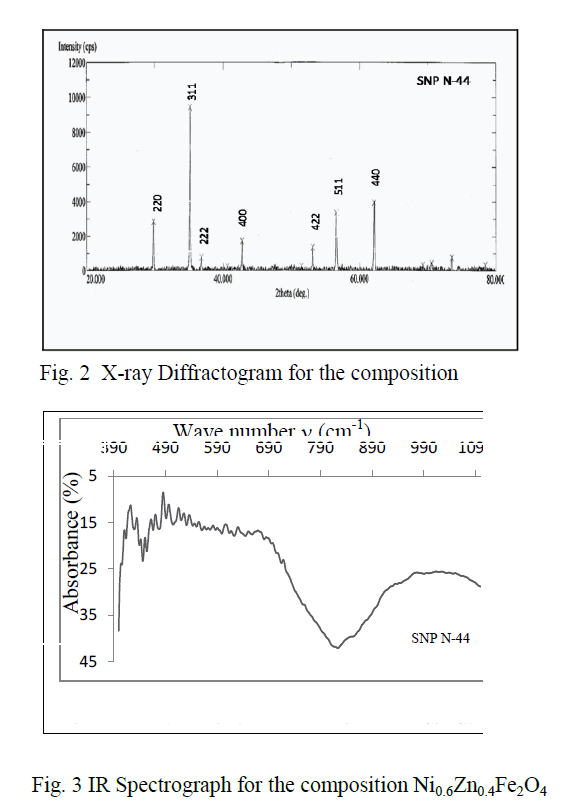 |
| A. Temperature Dependant DC Electrical Resistivity Measurement : DC electrical resistivity of the compositions under investigation is measured by using two probe methods in the temperature range from 300K to 773 K. The experimental arrangement is presented in fig 4. The graphs of log resistivity (log ïÃÂò) against reciprocal temperature (1000/T) for temperature above 80 0C were plotted and presented in fig 5. From these graphs, it is observed that variations of the log ïÃÂò with temperature show negative coefficient of resistance obeying Wilson`s relation for temperature above 80 0C [19]. However, the results regarding variations of resistivity against temperature near about room temperature show different behavior. |
| The graphs of log ïÃÂò against reciprocal temperature show strong decrease in resistivity with increase in temperature, which is attributed to the conductivity due to thermally activated mobility of the charge carriers [20]. This nature of electrical conductivity is usually due to hopping of electrons between multivalent cations situated on octahedral (B) sites. |
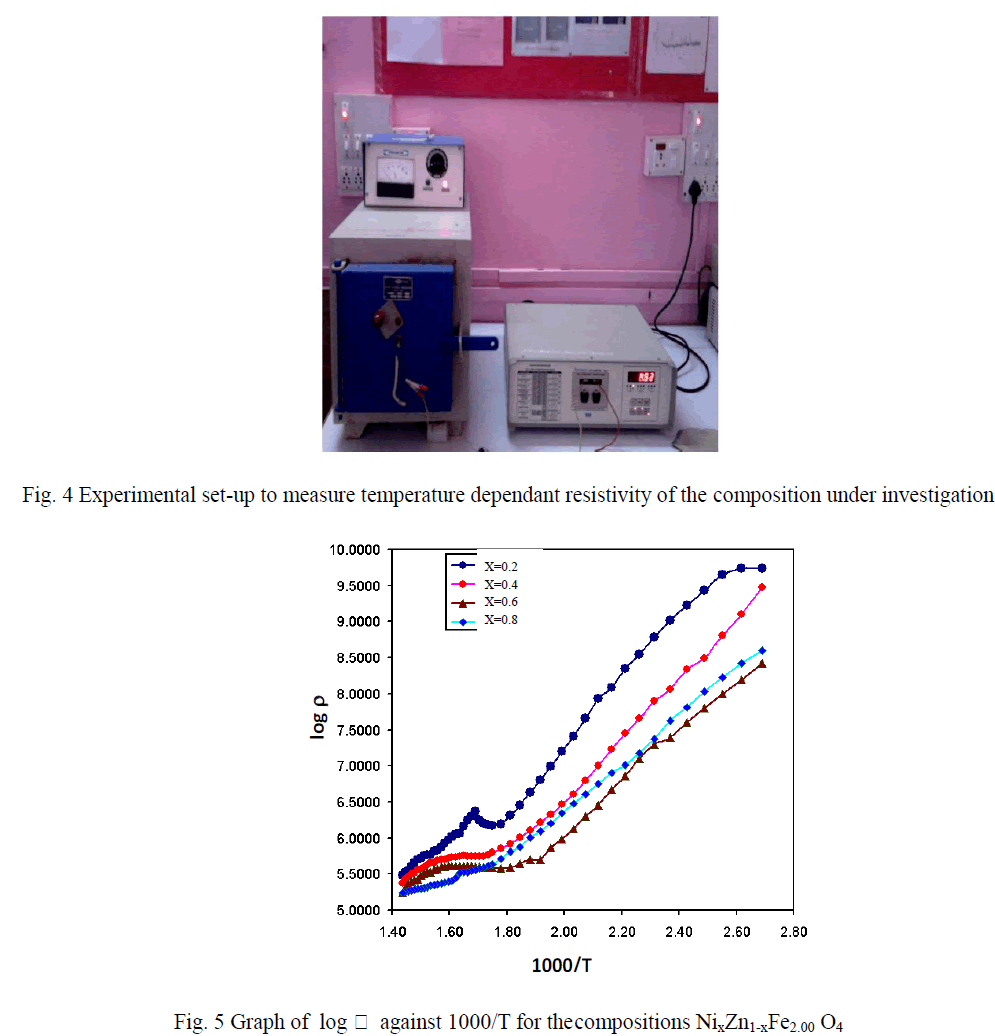 |
| On inspection of these figures, it is found that the linear relationship of log ïÃÂò against 1/T shows two breaks for x =0.20, 0.40, 0.60 & 0.80 at temperature Th and Tc. EI Hitti also reported two such breaks for Zinc substituted Mg and Ni ferrites [21]. This reveals that the electrical conductivity is strongly influenced by the magnetic ordering [21]. On passing through the Curie point (Tc), the change in the slope of the straight line must occur and the magnitude of this effect depends on exchange interaction between outer and inner electrons [22]-[23]. The region before Curie point is ferrimagnetic, whereas after Curie point the compositions become paramagnetic. The first break in the plot of log ïÃÂò against 1/T is related to magnetic phase transition, whereas second break is at Tc gives Curie temperature. |
| B. Humidity Dependant DC Electrical Resistance Measurement: At the room temperature, the composition is showing low resistance and resistance found increasing with increase in temperature up to certain temperature (Thum). That means the compositions are showing positive temperature coefficient up to Thum. After temperature, Thum, the compositions are obeying Wilson`s equation showing negative temperature coefficient of resistance. This abnormal behaviour of electrical conductivity can be attributed to sensitivity of the composition to the relative humidity of the atmosphere and photonic conduction mechanism [24], instead of electronic hopping mechanism, which is otherwise existing at elevated temperature. Therefore, the investigations are also made with variable humidity of the atmosphere. |
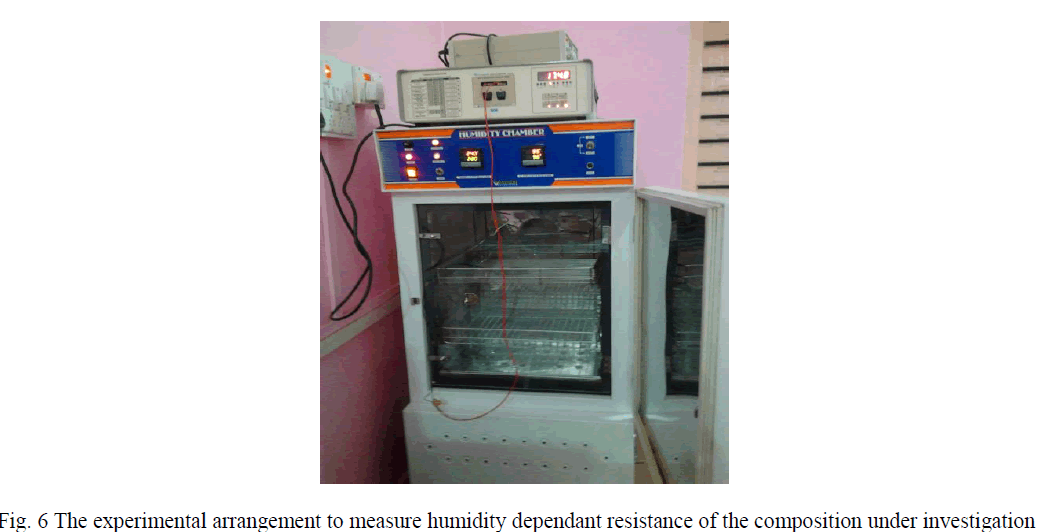 |
| Humidity is the environmental factor affecting many industrial and agricultural sectors. Therefore, it is the important to monitor the same very accurately. There are three groups of materials used as humidity sensors: electrolyte, organic, polymers and ceramics [25]. In general, commercially developed humidity sensors are mainly made of polymer film and ceramics [26]. Ceramics have the advantage of better mechanical, thermal and chemical stability. The ceramic materials previously studied include TiO2 [27], MgAl2O4 [28], ZnCr2O4 [29], ïÃÂá-hematite [30] and ZnMn ferrite [31]. However, the compositions under investigations NiZn ferrites are also revealing the humidity related properties. |
| The resistances of the compositions under investigations are measured within humidity from 30RH% to 90RH%. The experimental arrangement is presented in fig 6. The graph of resistance ( R ïÃÂÃâ) against humidity in RH % is plotted and presented in fig 7. On inspection of figure 7, it is found that the resistance of the compositions decreases with increase in humidity. The exponential nature of the graph reveals that in the beginning, resistance decreases rapidly, whereas for upper range of humidity slow decrease in resistance is observed. From this it can be said that the nature of the graph obeys the relation |
| Where A and B are the constants depends upon material compositions. This nature of the graph can be attributed to the conduction mechanism. In addition to the hopping mechanism, the ferrite exhibits protonic conduction mechanism [32]-[33]. |
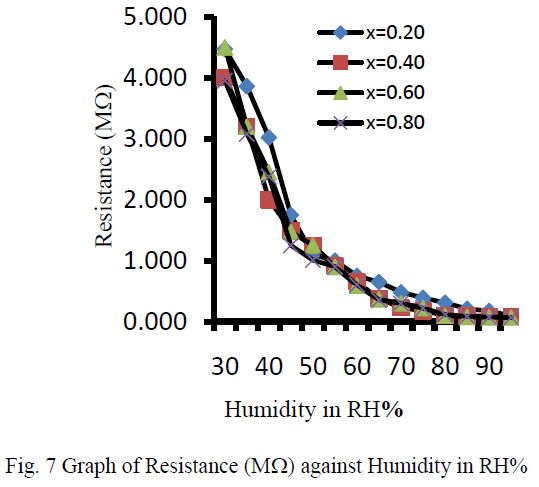 |
| The water molecules (H2O) are trapped into the pores of compositions. These water molecules contribute the electrical conduction. The water molecules have H+ ions and OH- ions. The H+ ion helps to carry electric current. Therefore, as humidity applied to compositions increases, the concentration of H+ ions increases which contribute to the electrical conduction. Hence, resistance of the compositions decreases with increase in the humidity. The nature of graph of resistance against temperature recommends the use of compositions, under investigation, for development of humidity sensor module. |
| C. Development of an embedded system for humidity measurement: Thick films of the composition are prepared by using screen printing techniques. A backelite material is used as a substrate. As shown in the fig 8, the film is printed to ensure the interdigited electrodes. A silver paste is used to made ohmic contacts. |
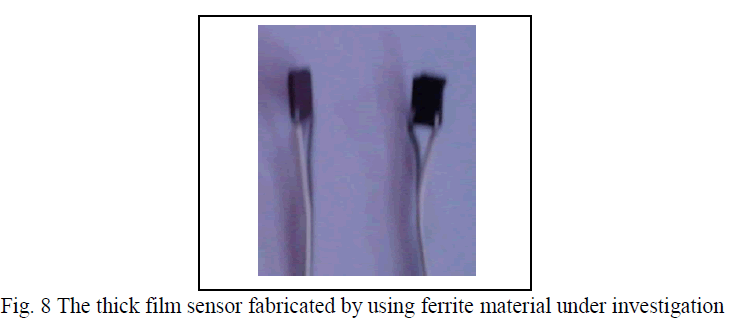 |
| Thus prepared sensor is implemented for the design of an embedded system to measure humidity of the environment. The sensor is resistive type and therefore, it is wired in resistive divider configuration [fig 1]. It is biased with stable potential and resulting emf produced across R2 [1KïÃÂÃâ] is extracted and amplified by instrumentation amplifier AD 620. An offset voltage, produced due to humidity at room condition is also compensated. The system is exposed to the variable humidity from 30% RH to 95% RH by employing highly precise and fully control humidity chamber form Gayatri Scientific, India and resulting emf measured. The graph observed emf from data acquisition system against applied humidity is plotted and presented in fig 9. From fig 9, it can be said that the nature of the graph supports the recommendation of polycrystalline ferrite material for development smart humidity sensor module. This graph is used for calibration of the system. Employing this graph and adopting standard curve fitting procedure an impirical relation (equation) is obtained. |
 |
| Where, VH is the humidity dependent voltage in (mV) and RH is the applied relative humidity. This expression is used in the firmware. Therefore, the emf produced by the sensor is converted into humidity in RH% and displayed on the smart LCD, which is configured in time delay mode. Thus, the system is calibrated to humidity in RH % and standardized with sophisticated equipments. |
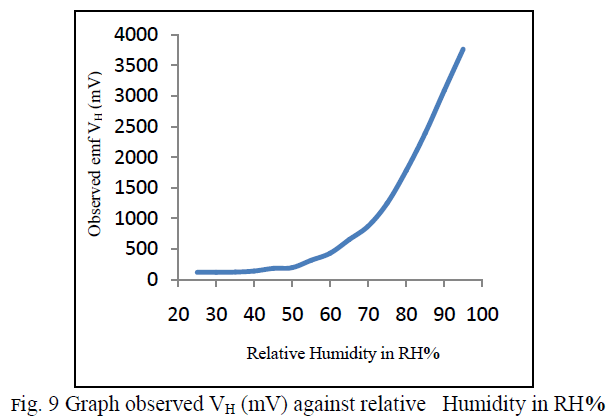 |
| D. Implementation of smart sensor material to measure humidity: A humidity sensor module, an embedded design is implemented to measure humidity of the environment. The present system is exposed to the humidity from 30RH% to 95%RH and the recovered observations are presented in table 1. On inspection of table 1, it is found that the humidity readings shown by the system under investigation and that of shown by humidity chamber are closely matched. This supports the reliability in the embedded system design. |
| Thus, standardized system is also implemented to measure humidity of diverse environment. It is implemented |
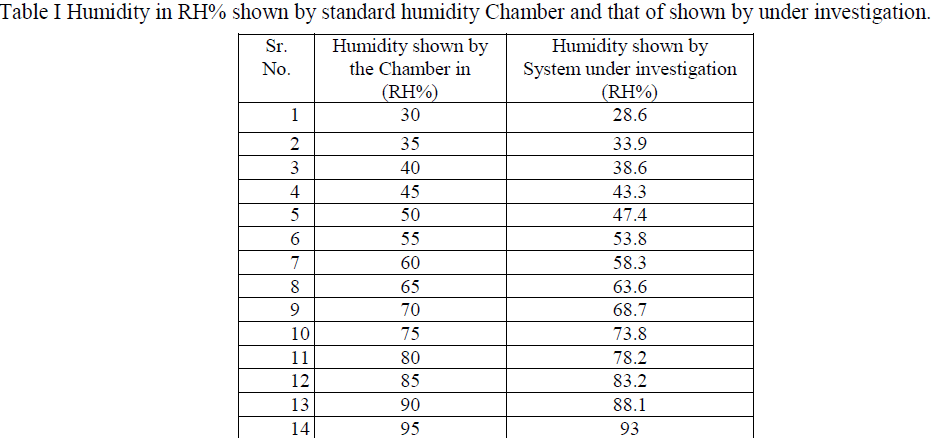 |
| Thus, standardized system is also implemented to measure humidity of diverse environment. It is implemented to measure humidity of polyhouse environment. The time dependant data is plotted and presented in figure 10. From figure 10, it is found that humidity of polyhouse environment displayed on the LCD. The increase as well as decrease in the humidity due to actuation of foggers. The graph revels, the feet that, variation in the humidity is localized and also its dependency on time |
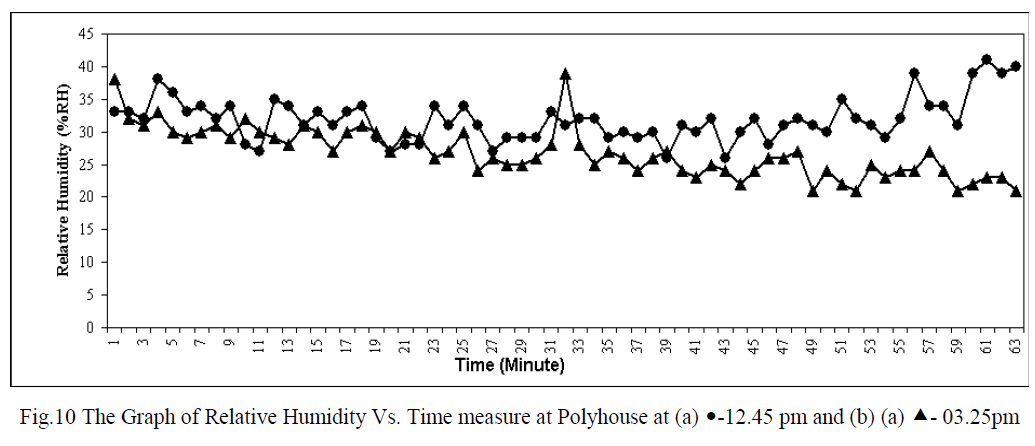 |
IV. CONCLUSION |
| The characterization of synthesized polycrystalline NiZn ferrite material reveals formation of single phase spinel compositions. The DC resistivity of the compositions under investigation shows negative temperature coefficient of resistance for the temperature range above 80oC. However, near about room temperature, the variation in the DC resistance shows anomalous behaviour. It exhibit decrease in the resistance with increase in the humidity. This behaviour could be attributed to the protonic conduction mechanism. Deploying these materials theinter digited thick film sensors are fabricated and used to develop an embedded system for measurement of humidity. On inspection of the data obtained from the system, it can be concluded that the system provides the data with high preciseness. |
References |
|